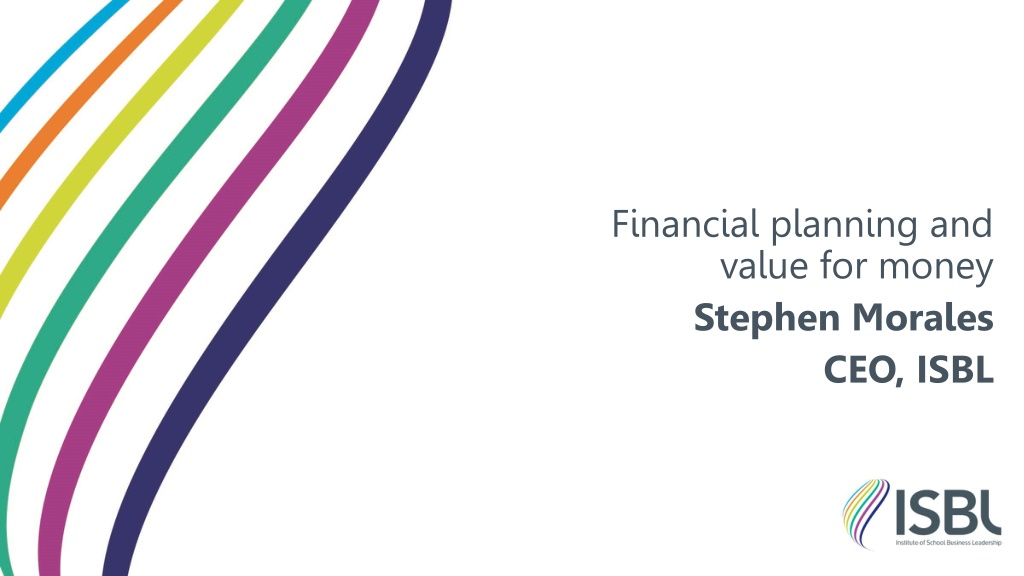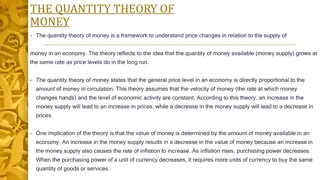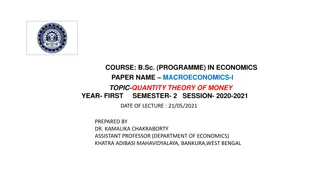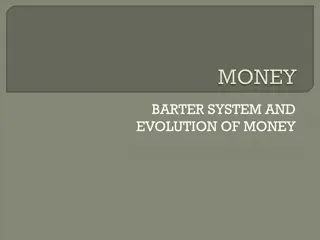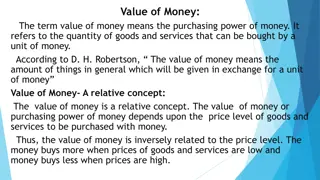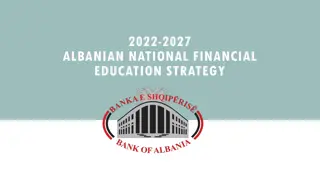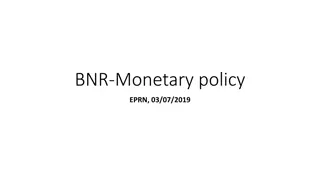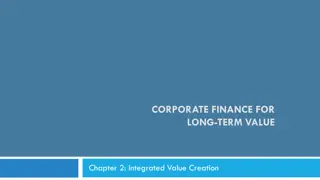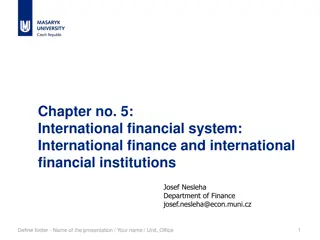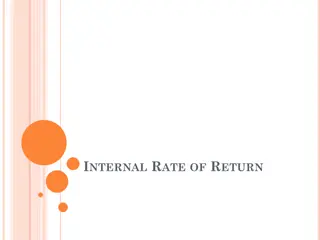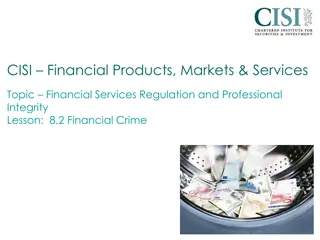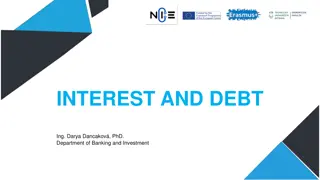Financial Planning and Value for Money in Education
Explore key aspects of financial planning in education, including knowing essential numbers, applying checks for budget efficiency, and analyzing staff pay percentages. Learn how to develop a strategic plan and compare your school's spending with benchmarks for improved financial management.
Download Presentation

Please find below an Image/Link to download the presentation.
The content on the website is provided AS IS for your information and personal use only. It may not be sold, licensed, or shared on other websites without obtaining consent from the author.If you encounter any issues during the download, it is possible that the publisher has removed the file from their server.
You are allowed to download the files provided on this website for personal or commercial use, subject to the condition that they are used lawfully. All files are the property of their respective owners.
The content on the website is provided AS IS for your information and personal use only. It may not be sold, licensed, or shared on other websites without obtaining consent from the author.
E N D
Presentation Transcript
Financial planning and value for money Stephen Morales CEO, ISBL
Financial planning and value for money What to have in place What to look out for Developing a strategic plan Slide 1
Know your numbers 1. Staff pay as percentage of total expenditure 2. Average teacher cost 3. Pupil-to-teacher ratio (PTR) 4. Class sizes 5. Teacher contact ratio Slide 2
Know your numbers 6. Proportion of budget spent on the leadership team 7. 3- to 5-year budget projections 8. Spend per pupil for non-pay expenditure lines compared to similar schools 9. School improvement plan priorities and the relative cost of options 10.List of contracts with costs and renewal dates Slide 3
Applying the 10 checks Use these 10 checks early in the annual budget planning cycle and when looking ahead at the 3- to 5-year position Adopt a joined-up approach to leadership. You should be consulting your school business professional as well as your head teacher or CEO Compare your school s spending with other schools in similar circumstances via the DfE benchmarking site You don t need to be a slave to these numbers, but knowing where you sit nationally might be the start of an important efficiency conversation Slide 4
1. Staff pay as percentage of total expenditure Staff pay is the single most expensive item in the school budget. It typically represents over 70% of expenditure. Questions you might want to ask as part of the governance challenge could include: What percentage of the budget is spent on staffing compared with similar schools? How does the percentage for teaching staff, curriculum support staff and other support staff compare with other similar schools? Slide 5
1. Staff pay as percentage of total expenditure How do your school s pupil outcomes such as your school s progress score compare with other similar schools, relative to spend on staffing? What is the overall staff cost as a percentage of total income? Staffing costs over 80% of total income are considered high. If teaching costs are relatively high, is this due to the number of teachers or a relatively high proportion of highly-paid staff/leadership? Slide 6
2. Average teacher cost This measure is calculated by dividing the total teaching cost by the full-time equivalent (FTE) number of teachers. You might want to ask: If the average teacher cost is high in comparison with other similar schools, why is this? Is this due to: the staffing grade profile, such as a high number of staff on the upper pay scale, or the responsibilities structure in the school, such as the Teaching and Learning Responsibility (TLR) scale, or another reason? Slide 7
3. Pupil-to-teacher ratio (PTR) The pupil-to-teacher ratio (PTR) is calculated by dividing the number of FTE pupils on roll by the total number of FTE teachers. A relatively low PTR could suggest small class sizes. As well as benchmarking the PTR, you may want to review the average PTR and pupil to adult (teachers and support staff) ratios in other schools and academies. The ratio of pupils to all educational staff (including teaching assistants) is also relevant, especially in primary schools. Research findings suggest teaching assistants are a high cost intervention with a mixed impact on pupil education levels, depending upon how they are deployed. Slide 8
3. Pupil-to-teacher ratio (PTR) You might want to ask: What is the PTR for different key stages within their schools? How does the school s PTR compare with similar schools? If it s significantly different, what is the reason for this? How does the ratio of pupils to staff compare with similar schools? Slide 9
4. Class sizes The smaller the class size, the greater the cost of delivery per pupil. Governors should ensure that class size plans are affordable while supporting the best outcomes for pupils. You might want to ask: What are the average class sizes by key stage and by options at key stages 4 and 5? What class sizes does your school aim to achieve and what is the educational reason for this? Slide 10
4. Class sizes Are there any small classes where the per pupil funding does not cover the cost of delivery? This can be especially important at key stage 4 and 5 where class sizes for some subjects can fall. Do you know the maximum average class size that the school can operate at within the context of the pupil admissions, the structure of the building, the numbers in different year groups and the need for intervention strategies? Slide 11
5. Teacher contact ratio This measure is calculated by taking the total number of teaching periods timetabled for all teachers in the school and dividing that by the total possible number of teaching periods (the number of teaching periods in the timetable cycle multiplied by the FTE teachers). All teachers should have a guaranteed minimum of 10% timetabled planning, preparation and assessment (PPA) time. Therefore, the teacher contact ratio will always be lower than 1.0. Slide 12
5. Teacher contact ratio You might want to ask: How would changes to the teacher contact ratio impact on the overall budget? Are teaching staff undertaking roles that could be done by support staff? How does your school compare against ICFP national benchmarks? We ll come on to this a little later. Slide 13
6. Proportion of budget spent on the leadership team Schools have many different leadership and management structures, and comparisons are not straightforward. Some schools calculate the cost of non-class-based leadership time as a percentage of total expenditure and compare to similar schools by collaborative exchanges of summary information. Likewise, multi-academy trusts can compare across their member schools where they are similar. Slide 14
6. Proportion of budget spent on the leadership team You might want to ask: How does this compare with similar schools, taking into account any contact time the leadership staff have? If there is more than one school in your trust or federation, are the leadership structures proportionally the same? How has your school made decisions on the proportion of its budget to be spent on the leadership team? If this is relatively high or low compared with similar schools, is this because of the size of the leadership team, or their pay? Slide 15
7. 3- to 5-year budget projections You should ask to see 3- to 5-year financial projections and the assumptions made to cost them. Assumptions you may want to review include: projected pupil numbers free school meal numbers likely pupil premium income projections of the staffing that will be necessary in these years Slide 16
7. 3- to 5-year budget projections Schools should plan their staffing based on multi-year projections of curriculum needs. You might want to ask: How confident are you that pupil number projections are realistic? If there is uncertainty, then boards should be given 3 scenarios: cautious, likely, and optimistic. If the optimistic scenario indicates financial difficulties, is the school developing a recovery plan now? Slide 17
7. 3- to 5-year budget projections If the cautious budget indicates potential financial difficulties, what contingency plans does the school have to overcome them? Are there any issues in the medium term that should be addressed now? How will current decisions impact medium-term budgets? What do we need to put in place now to ensure we have the necessary funding in the future? Slide 18
8. Spend per pupil for non-pay expenditure lines compared to similar schools You might want to ask: What is the spend per pupil for catering, ICT, estates management, business administration, energy and curriculum supplies? If benchmarking indicates a relatively high spend on a particular expenditure line, do you know why? Are the reasons unavoidable, or are further efficiencies possible? Slide 19
8. Spend per pupil for non-pay expenditure lines compared to similar schools If the cost of energy seems high compared with similar schools, can you invest in energy-saving measures to reduce the cost? If spend on learning resources seems high compared to similar schools, are there opportunities for collaborating with other local schools to bring costs down? Multi-academy trust (MAT) trustees may also want to compare their level of top slice to other MATs, what it is used for, and how it provides value for money for member academies. Slide 20
9. School improvement plan priorities and the relative cost of options The budgetary process sits firmly within the strategic leadership framework and should link into the overall management and planning cycle, rather than being seen as an additional activity that is the responsibility of the finance manager. (Later we will talk about joined-up leadership.) You might want to ask: Are school improvement initiatives prioritised, costed and linked to the budget? Are all new initiatives fully costed before your school is committed to the proposal? Slide 21
10. List of contracts with costs and renewal dates Each year, your school must review its contracts for all of its services to check which ones are due for renewal. Check that contracts are good value for money (VFM) and meet the school s needs. You might want to ask: Are all contracts due for renewal re-tendered/reviewed for VFM before renewal? Slide 22
10. List of contracts with costs and renewal dates Are there any regular payments for services that are an invoice- only contract? Include all goods and services on a contracts list, including single-item and routine purchases, such as stationery. Check all suppliers are on contracts list and review the overall list for VFM. Slide 23
Bringing it all together through joined-up decision-making and ICFP Slide 24
The three pillars of education leadership Pedagogy Children Business Governance Slide 25
Strategic prioritisation through an integrated approach to curriculum-led planning Timetabled periods needed Pupil numbers Year group Minimum class size Period 1 Period 2 Period 3 Period 4 Y7 Y8 Y9 Y10 Y11 Know your contact ratios TOTAL A Consider space allocation optimisation Opportunities for aggregation and economies of scale % of overall budget Value DfE funding revenue/pupil Other income TOTAL B Leadership Teaching Supply & cover Teaching support Back office administration Premises Professional services CPD Classroom resources & equipment Central services top slice TOTAL A + TOTAL B + TOTAL C must = BALANCED BUDGET TOTAL C Slide 26
What is ICFP? ICFP stands for Integrated Curriculum Financial Planning ICFP is an important way to review a school s financial and resource management planning and use against its widest curriculum delivery aims. It integrates the school and trust s teaching and learning ambitions and financial resource management into one approach ICFP uses a reasonably simple set of metrics that assist with collaborative decision-making across the leadership triangle, requiring involvement from school business professionals, senior pedagogical leaders and governors/trustees Slide 27
What is ICFP? It is important to mention that ICFP isn t a new idea and many schools use it to a greater or lesser extent. It isn t a reaction to a difficult financial situation but should be used as a proactive way of planning and using resources efficiently There is no prescribed way of implementing ICFP, but there are several well-established approaches in use in the sector When implemented fully, ICFP can be used to provide the analytical evidence that will inform the medium-term strategic planning as well as the short-term operational management action planning and collaborative decision-making of school business professionals, senior school leaders and governors Slide 28
What metrics does ISBL use? Slide 29
I-SOT: ISBLs unique tool Visit https://isbl.org.uk/training/isot.aspx for more information Slide 31
